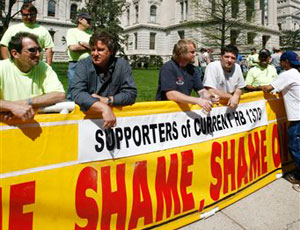If ever there were a dispute in which the outcome depended on the details, it is the question of whether a union may legally display banners or inflatable rats or hold mock funerals outside of businesses that use open-shop contractors. Is it free speech or an illegal boycott under the labor law? With one exception, we think the highly politicized National Labor Relations Board got this decision right—the 3-2 vote that supported the United Brotherhood of Carpenters and Joiners of America, Local 1506, in Arizona.

There are at least 10 other cases pending involving the use of banners.
Since 1947, the nation’s labor law has prohibited unions from threatening, coercing or restraining a secondary employer not directly involved in a primary labor dispute. The ban applies if the union is trying to force the secondary employer to cease doing business with the primary employer. According to the board, picketing that promotes a consumer boycott is banned; handbills are OK.
Because the best interests of the industry rest on having robust union and open-shop employers, the industry is better off if the labor law is interpreted by the board so that both are healthy.
The Arizona carpenters set up banners at the Thunderbird Medical Center in Phoenix, the Northwest Medical Center in Tucson and the RA Tempe restaurant in Tempe. The union wanted to protest the use of four open-shop drywall, interiors and concrete contractors, so they set up banners facing the street; several union people held them near entrances of the establishments.
The crux of the issue is whether the union actions are coercive. On the banners at the medical centers were the words “SHAME ON,” followed by each medical center’s name. At the restaurant, the banners read, “DON’T EAT ‘RA’ SUSHI.”
Although the two dissenting board members considered the majority to be hair-splitters and said bannering, as it is called, is no different from coercive picketing, we think the majority acted wisely. The union conduct seems aggressive but not coercive. As the carpenters’ general counsel said, there’s nothing wrong with putting your views on a banner.
Our regret in this decision is that the board could not speak to the differences between the establishments. Medical centers and hospitals aren’t likely to lose customers from banner protests, but restaurants, which depend on creating a pleasant experience for customers, are much more vulnerable.
The dissenters say Congress intended the labor law’s relevant sections to be applied flexibly and sensibly and that the majority “put the neutral party right back into the fray.”
Maybe so. Yet as long as union members are not intimidating or threatening customers from coming and going to a place of business, unions are entitled to their say in courts, on websites and in the streets.

Post a comment to this article
Report Abusive Comment